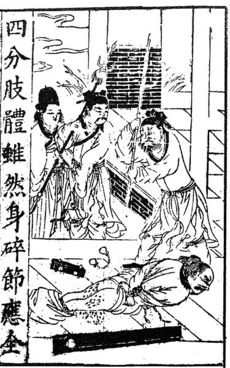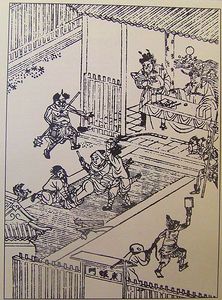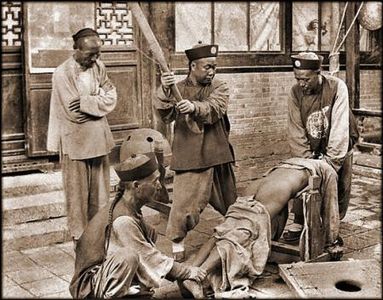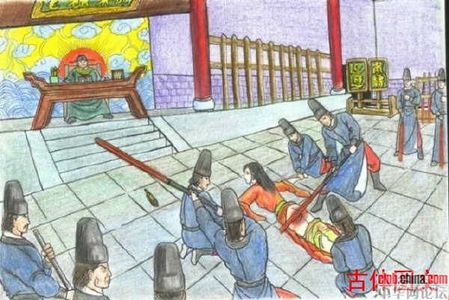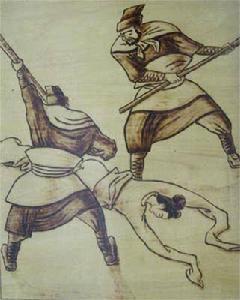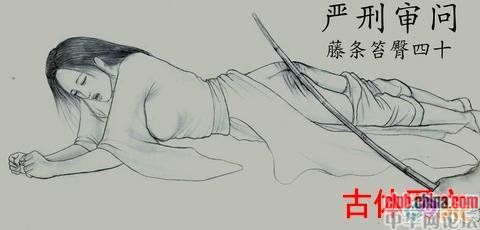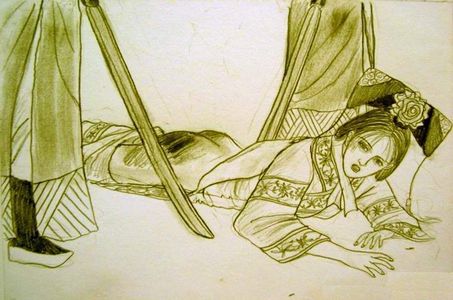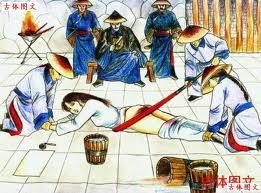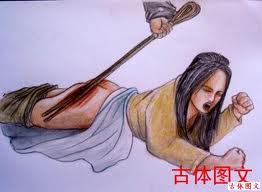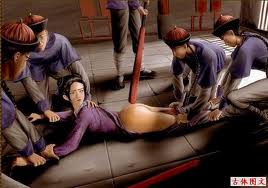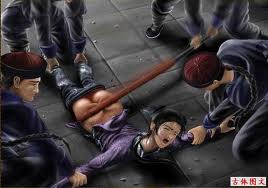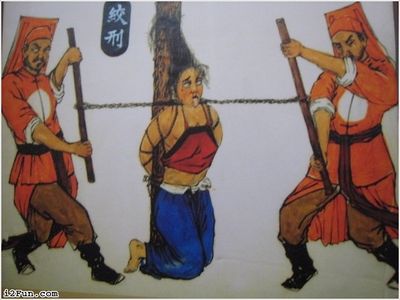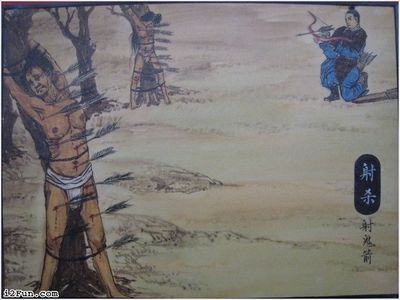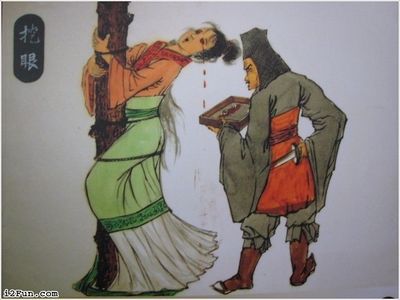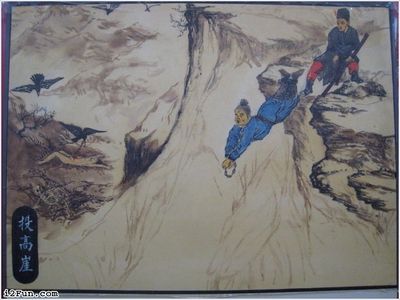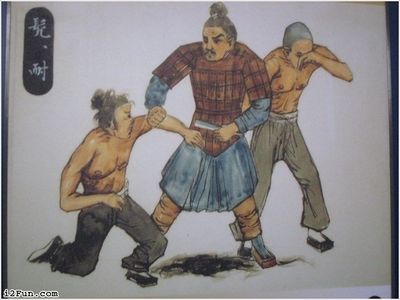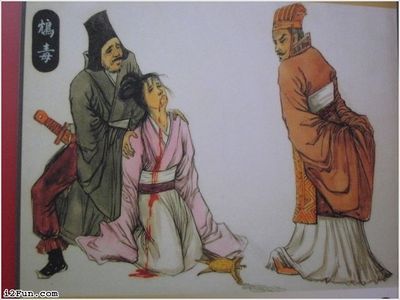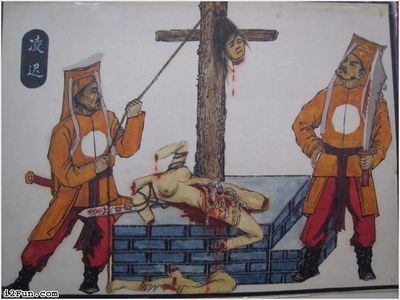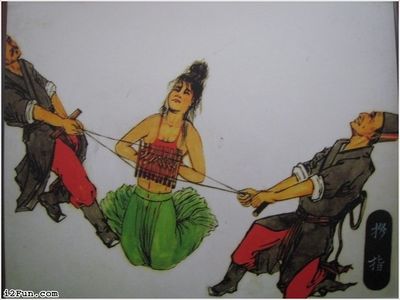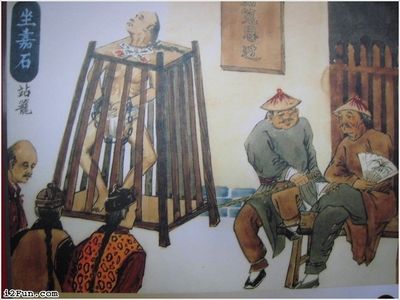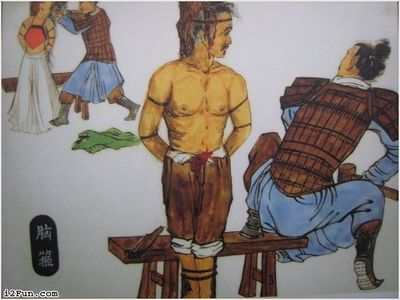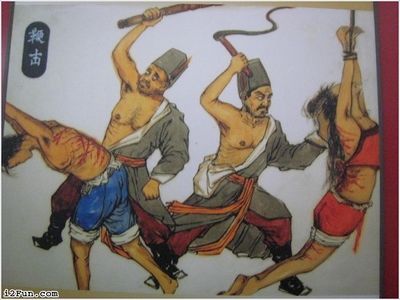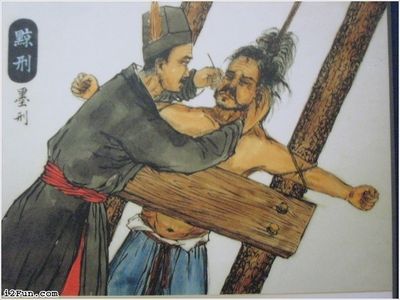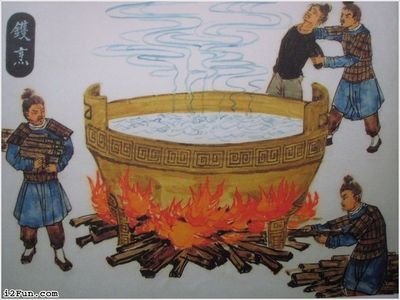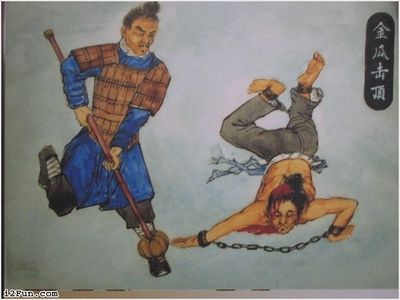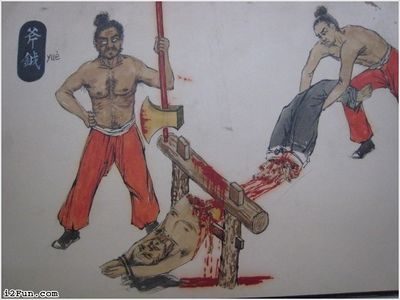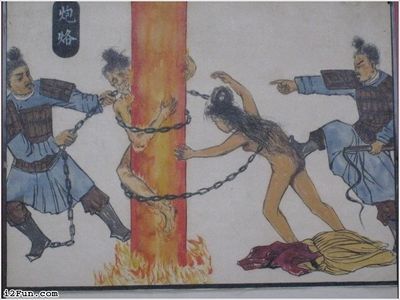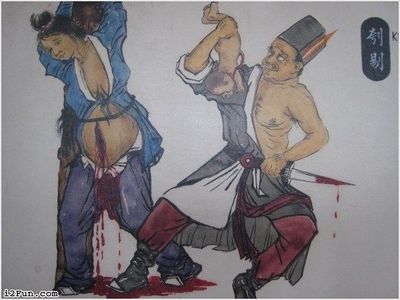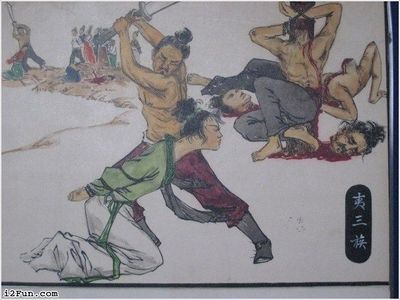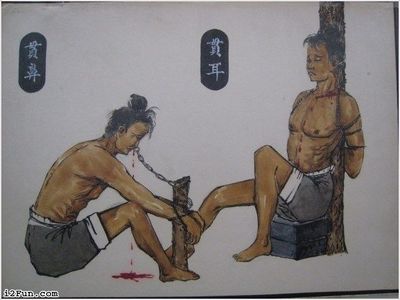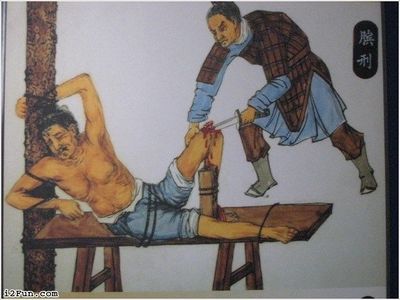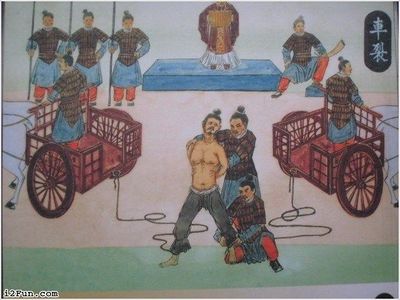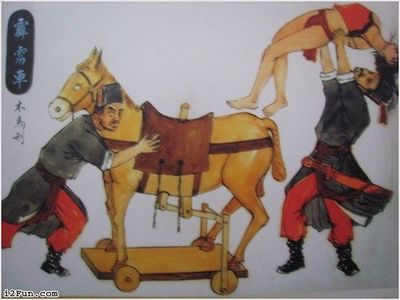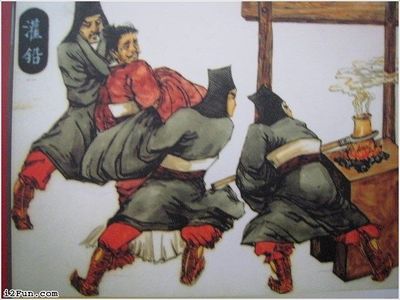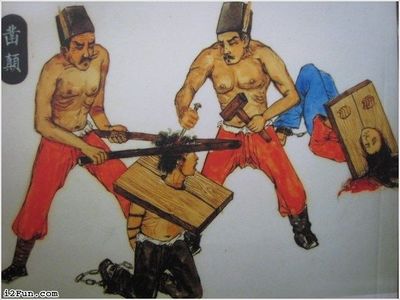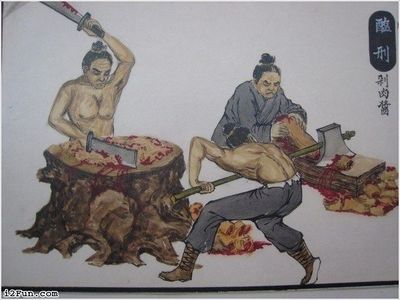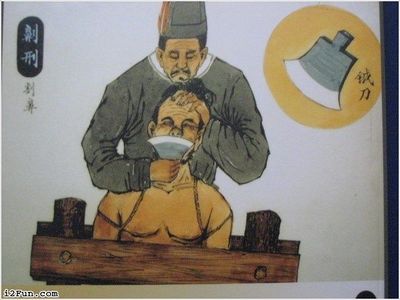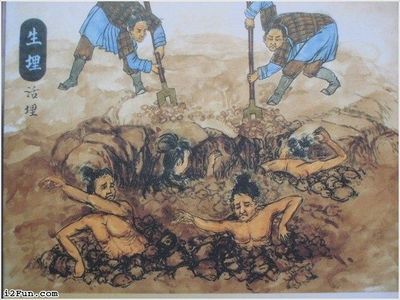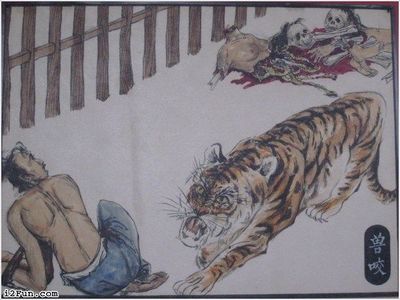Chi Zhang: Difference between revisions
m (Text replacement - "{{Page-ok|10/20}}" to "") |
No edit summary |
||
| (4 intermediate revisions by the same user not shown) | |||
| Line 5: | Line 5: | ||
== History == | == History == | ||
'''''Chī''''' refers to a [[whipping]] with a light [[bamboo]] or [[rattan]] stick (similar to a [[cane]]) or a bunch of such | '''''Chī''''' refers to a [[whipping]] with a light [[bamboo]] or [[rattan]] [[stick]] (similar to a [[cane]]) or a bunch of such [[stick]]s bound together (similar to a [[birch]]); '''''Zhàng''''' refers to a beating with a wooden staff or a [[paddle]] with a long handle. In both cases, the punishment was usually administered on the [[buttocks]], but in some cases they had been applied to the [[back]] and [[thigh]]s as well. The dimensions of the [[spanking implement|implement]]s were specified by the government during certain periods in Chinese history. [[Whip]]s were not used for ''chī zhàng'', but they were commonly used in [[torture]]. | ||
In general, ''zhàng'' was much more severe than ''chī'' due to the nature of the implement used. The number of strokes inflicted was up to the discretion of the judge, and could range from 20 to 100 (or much more) at any one point. Those subjected to this form of corporal punishment usually ended up sustaining severe injuries, which caused them to become scarred or handicapped for the rest of their lives, or, in the worst cases, resulted in death. | In general, ''zhàng'' was much more severe than ''chī'' due to the nature of the implement used. The number of strokes inflicted was up to the discretion of the judge, and could range from 20 to 100 (or much more) at any one point. Those subjected to this form of corporal punishment usually ended up sustaining severe injuries, which caused them to become scarred or handicapped for the rest of their lives, or, in the worst cases, resulted in death. | ||
| Line 38: | Line 38: | ||
== Gallery == | == Gallery == | ||
<gallery mode="packed" heights="200px" caption=""> | |||
<gallery> | |||
Image:Historic judicial cp in china.jpg|An old print showing a ''zhàng'' punishment being carried out in court. | Image:Historic judicial cp in china.jpg|An old print showing a ''zhàng'' punishment being carried out in court. | ||
File:China-paddle.jpg|Photograph of a ''zhàng'' punishment in progress, taken in the late Qing Dynasty (c. 1900s). | File:China-paddle.jpg|Photograph of a ''zhàng'' punishment in progress, taken in the late Qing Dynasty (c. 1900s). | ||
| Line 49: | Line 48: | ||
Image:Ancientchinacorporalpunishment6.jpg|Color drawing of a ''chī'' punishment, by an unknown artist. | Image:Ancientchinacorporalpunishment6.jpg|Color drawing of a ''chī'' punishment, by an unknown artist. | ||
Image:Ancientchinacorporalpunishment7.jpg|Rendered art showing a ''zhàng'' punishment in court, by an unknown artist. This takes place in the Qing Dynasty. | Image:Ancientchinacorporalpunishment7.jpg|Rendered art showing a ''zhàng'' punishment in court, by an unknown artist. This takes place in the Qing Dynasty. | ||
Image:Ancientchinacorporalpunishment8.jpg|A follow-up to the picture | Image:Ancientchinacorporalpunishment8.jpg|A follow-up to the previous picture. | ||
</gallery> | |||
{{chain}} | |||
<gallery mode="packed" heights="200px" caption=""> | |||
image:Ancient-China-Torture-001.Jpg|Ancient China Torture 001 | |||
image:Ancient-China-Torture-002.Jpg|Ancient China Torture 002 | |||
image:Ancient-China-Torture-003.Jpg|Ancient China Torture 003 | |||
image:Ancient-China-Torture-004.Jpg|Ancient China Torture 004 | |||
image:Ancient-China-Torture-005.Jpg|Ancient China Torture 005 | |||
image:Ancient-China-Torture-006.Jpg|Ancient China Torture 006 | |||
image:Ancient-China-Torture-007.Jpg|Ancient China Torture 007 | |||
image:Ancient-China-Torture-008.Jpg|Ancient China Torture 008 | |||
image:Ancient-China-Torture-009.Jpg|Ancient China Torture 009 | |||
image:Ancient-China-Torture-010.Jpg|Ancient China Torture 010 | |||
image:Ancient-China-Torture-011.Jpg|Ancient China Torture 011 | |||
image:Ancient-China-Torture-012.Jpg|Ancient China Torture 012 | |||
image:Ancient-China-Torture-013.Jpg|Ancient China Torture 013 | |||
image:Ancient-China-Torture-014.Jpg|Ancient China Torture 014 | |||
image:Ancient-China-Torture-015.Jpg|Ancient China Torture 015 | |||
image:Ancient-China-Torture-018.Jpg|Ancient China Torture 018 | |||
image:Ancient-China-Torture-A01.Jpg|Ancient China Torture A01 | |||
image:Ancient-China-Torture-A02.jpg|Ancient China Torture A02 | |||
image:Ancient-China-Torture-A03.Jpg|Ancient China Torture A03 | |||
image:Ancient-China-Torture-A04.Jpg|Ancient China Torture A04 | |||
image:Ancient-China-Torture-A05.Jpg|Ancient China Torture A05 | |||
image:Ancient-China-Torture-A06.Jpg|Ancient China Torture A06 | |||
image:Ancient-China-Torture-A07.Jpg|Ancient China Torture A07 | |||
image:Ancient-China-Torture-A08.Jpg|Ancient China Torture A08 | |||
image:Ancient-China-Torture-A09.Jpg|Ancient China Torture A09 | |||
image:Ancient-China-Torture-A10.Jpg|Ancient China Torture A10 | |||
image:Ancient-China-Torture-A11.Jpg|Ancient China Torture A11 | |||
image:Ancient-China-Torture-A12.Jpg|Ancient China Torture A12 | |||
</gallery> | </gallery> | ||
== See also == | == See also == | ||
* [[Gonjang]] | * [[Gonjang]] | ||
| Line 60: | Line 89: | ||
* [http://photocdn.sohu.com/20120101/Img330964143.jpg Color drawing of a man and a woman being whipped on the back by prison guards] (MM/MF) by an unknown artist. The Chinese words on the top left read: "Whipping" (鞭击) | * [http://photocdn.sohu.com/20120101/Img330964143.jpg Color drawing of a man and a woman being whipped on the back by prison guards] (MM/MF) by an unknown artist. The Chinese words on the top left read: "Whipping" (鞭击) | ||
{{sa|Chinese punishment}} | |||
{{sa-judicial}} | {{sa-judicial}} | ||
{{ | {{cat|History|Torture devices}} | ||
Latest revision as of 03:09, 24 January 2023
Chi Zhang (Chinese: 笞杖; Pinyin: chī zhàng) is a collective term referring to the two main types of judicial corporal punishment in ancient China—chī (笞) and zhàng (杖). The terms for these punishments are sometimes translated into English as "caning" even though they are not exactly similar to traditional British-style canings.
History
Chī refers to a whipping with a light bamboo or rattan stick (similar to a cane) or a bunch of such sticks bound together (similar to a birch); Zhàng refers to a beating with a wooden staff or a paddle with a long handle. In both cases, the punishment was usually administered on the buttocks, but in some cases they had been applied to the back and thighs as well. The dimensions of the implements were specified by the government during certain periods in Chinese history. Whips were not used for chī zhàng, but they were commonly used in torture.
In general, zhàng was much more severe than chī due to the nature of the implement used. The number of strokes inflicted was up to the discretion of the judge, and could range from 20 to 100 (or much more) at any one point. Those subjected to this form of corporal punishment usually ended up sustaining severe injuries, which caused them to become scarred or handicapped for the rest of their lives, or, in the worst cases, resulted in death.
Men were typically required to undress or simply bare their buttocks for the flogging, although sometimes they were allowed to keep their clothes on. Ancient Chinese law stated that women did not need to strip for the punishment for the sake of preserving their modesty, except when they were convicted of sex-related offenses (such as adultery). The act of committing a sex offense was seen as something disgraceful in ancient Chinese society, so, by the same argument, if the person was shameless enough to do something so disgraceful, then there was no need to protect that person's modesty during punishment.
Chī Zhàng was usually carried out in public (e.g. in court, in the town square) and on-the-spot (immediately after the judge gave the order). A typical chī zhàng session would be as follows: The judge would give the order by announcing it and thumping a block on the desk (the block was used in the same way as a gavel) or throwing a small wooden card shaped like the blade of a sword (with the order written on it) onto the ground. On receiving the order, the guards standing on either side of the hall would grab hold of the recipient and pin his/her limbs down on the ground and remove his/her clothing to expose the buttocks. The recipient would then receive the punishment in a lying position. In some cases, the recipient may be brought to a bench and laid flat on it to receive the punishment.
In spite of these regulations, corrupt officials often violated the laws by forcing women (regardless of whether they committed sex offenses or not) to strip completely naked for the flogging, in addition to using other illegal and perverse methods to humiliate the woman to satisfy their lust and voyeuristic desires. Many of these women were usually innocent, and they committed suicide as they could not bear with the shame.
Chī Zhàng may not necessarily be meted out as a penalty for committing certain offenses, as it was, among other methods, adopted as a means of torture to extract confessions out of suspected criminals or to force innocent people to confess to crimes they did not commit.
Zhàng was also employed as a form of military corporal punishment in ancient China for soldiers who broke military rules or defied orders.
Tíng-zhàng
Apart from commoners, even officials, aristocrats and nobles were not spared from corporal punishment as well. There were numerous instances of tíng-zhàng (廷杖, literally: "zhàng in court") throughout Chinese history, most notably during the Ming Dynasty (1368-1644). Tíng-zhàng refers to the mass zhàng punishment of officials (dozens of them at a time) in the imperial court, ordered by the emperor. In 1519, there was a tíng-zhàng incident where 146 officials were flogged and 11 of them died. Tíng-zhàng could also be ordered by a senior official to be administered to other officials of lower ranking. Tíng-zhàng was less common during the Qing Dynasty (1644-1912) but there was one notable incident in 1902 - Empress Dowager Cixi ordered Consort Zhen (a concubine of the Guangxu Emperor) to be flogged on the bare bottom with bamboo paddles.
Film and television
Chī Zhàng has been frequently reenacted in many movies and television dramas set in ancient China.
Other terms
Other terms used to describe chī zhàng include:
- chī-xíng (笞刑, lit. "whipping punishment")
- zhàng-xíng (杖刑, lit. "zhàng punishment")
- biān-chī (鞭笞, lit. "whipping"). This term is now commonly used in Chinese-language news reports when referring to judicial corporal punishment in countries like Singapore and Malaysia.
- biān-xíng (鞭刑, lit. "whipping punishment"). This term is used interchangeably with biān-chī, although it is more commonly used.
- zhàng-zé (杖責/杖责, lit. "punishment by zhang")
- dá bǎn-zi (打板子, lit. "beating with paddle")
Gallery
See also
Links
- Citizen Cane, a translated article on corporal punishment in China by Xing Bao on World Corporal Punishment Research
- Pictures of chī zhàng on World Corporal Punishment Research
- Color drawing of a man and a woman being whipped on the back by prison guards (MM/MF) by an unknown artist. The Chinese words on the top left read: "Whipping" (鞭击)
See also [ Chinese punishment ]
| Judicial punishment | |
|---|---|
